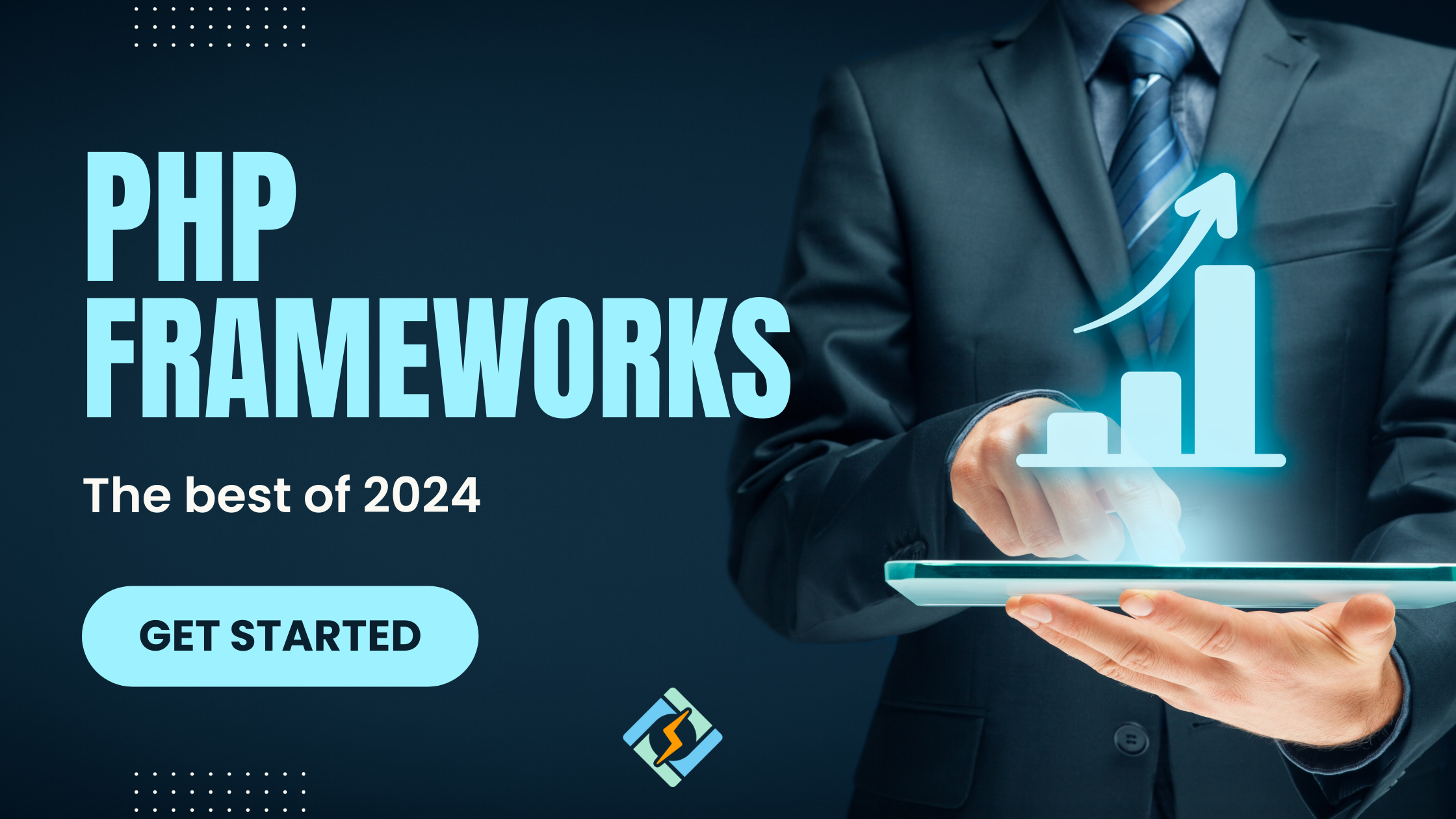We will explore the inner workings of frameworks today and reveal their mysteries.
A framework is like a foundation in Web Development, providing a structured starting point for building applications. It can feel like peeling an onion with each layer revealing new possibilities, complexities, and opportunities.
Let’s look at a simple real-world example here, Imagine constructing a house. You could lay the foundation and you may build the entire structure, but it would be time-consuming. Alternatively, if professional builders managed the foundation, it would save time, and effort and reduce the risk of errors.
PHP Frameworks, tailored to specific programming languages, serve similar functions. They are designed and rigorously tested by skilled developers, ensuring a reliable foundation for your projects. This structure allows developers to focus on adding higher-level functionality rather than starting from scratch. Additionally, frameworks are versatile, and suited for different tasks in software development.
Why do we use frameworks?
- Stronger coding
- Easier debugging and testing
- Preventing redundant code
- Code that is clear and scalable
- To concentrate on writing project-specific code
- Can be extended
Exploring PHP Frameworks?
In the world of PHP frameworks, every layer you add brings depth to your coding experience and enhances the quality of your projects. It is intuitively designed to create maximum ease of coding for developers.
PHP frameworks became important to web development projects as they became more complex and demanding. They emerged as a solution to common development challenges such as code organization, security vulnerabilities, and scalability issues. They follow the Model-View-Controller (MVC) architectural pattern, the term ModelandView represents data, business logic, and rules, Controller refers to the input that transforms into commands for Model and Views. Convert PPT to PDF
Get exclusive access to all things tech-savvy, and be the first to receive
the latest updates directly in your inbox.
A PHP framework is a set of preset classes, functions, and libraries that offer an organized method for developing PHP web applications. It streamlines the development process by providing a standardized way to streamline enforcing code standards and providing ready-to-use components that maximize faster project completion.
Why Use PHP Frameworks in Web Development?
The answer to this question is the several benefits it provides to organizations, Web Developers the main focus of our article today as well as all Ecommerce Platforms.
Today, PHP, an open-source scripting language that is used to create dynamic websites and web applications, has been installed on more than three-quarters of all web pages on the Internet.
- Rapid Development: PHP frameworks: provide pre-built components and libraries that streamline the development process, allowing developers to build applications more quickly.
- Code Organization: enforce a structured programming approach that facilitates the organization and maintenance of codebases, even when project complexity increases.
- Security: it comes with built-in security features and practices, such as input validation, protection against SQL injection, and authentication mechanisms, helping developers build more secure applications.
- Scalability: designed to accommodate the growth of web applications, making it easier to scale them as user traffic and data volume increase.
- Community Support: Popular PHP frameworks have large and active communities of developers who contribute to their improvement, offer support, and share resources, making it easier to troubleshoot issues and find solutions.
- Standards Compliance: To ensure code consistency and compatibility in the various projects and teams, frameworks are usually based on industry best practices and standards.
Overall, using a PHP framework can streamline development, making it an invaluable tool for web developers.
Factors to Consider when Choosing the Right PHP Framework
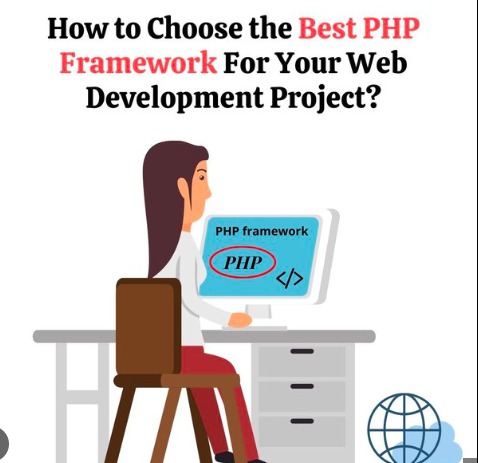
Selecting the right PHP framework is essential in the dynamic web development scene. It provides structure, power, and code manageability, significantly impacting project success.
However, choosing the best PHP framework requires a bit of research.
Here are a few questions to consider when planning on choosing a PHP framework.
- Does it accurately reflect the main objective of your application? Choose a domain and major objective for your blog website, whether it’s a company site, blog, social media platform, or e-commerce portal. Assess the complexity of your project and choose an adaptable, secure, and scalable framework with appropriate themes and plugins.
- What are the project’s size and level of complexity? Find out if your project is a large-scale business solution, a medium-sized application, or a small-scale website.
- Which levels of documentation and automation are available? Selecting a framework with comprehensive documentation will facilitate programmers’ comprehension of the source code and enable them to create applications more quickly. provides clear insights into the workflow and potential traps, guiding developers through the development process can easily understand the source code, adhere to best practices, and efficiently build applications. This ensures smoother development cycles, reduces errors, and enhances overall productivity.
- What is the security track record? Investigate the security features and track record of each framework. Look for frameworks with built-in security features, such as input validation, CSRF protection, and secure authentication tools.
- Is the framework backed by active support, through paid services or community-driven development? Consider the licensing model and cost implications of each framework. Determine if it fits your budget and needs premium features or support. Opting for a framework with robust support ensures developers have access to assistance and resources, including updates, bug fixes, and security patches. This support promotes a collaborative environment where developers can seek advice and share knowledge, mitigating risks and enhancing project success.
It is advised that you test out two or three frameworks before adding them to your tech stack to make an informed conclusion.
PHP Frameworks Reigning in 2024
In this digital era, Businesses are facing serious competition at every level when looking for the right Web Development tools to boost their projects, we all know the market is highly competitive. So If you’re a web Developer who is still confused about choosing the right PHP Framework for your business, look no further, we’ve got you covered. Keep reading through the whole article until the end and once you’re done reading you’ll have decided. Here’s our top pick for you!
Top 5 Best PHP Frameworks: What’s Trending in 2024?
Get a comprehensive guide on the most popular 5 PHP Frameworks in 2024, including their features, latest versions, and usage.

Symfony
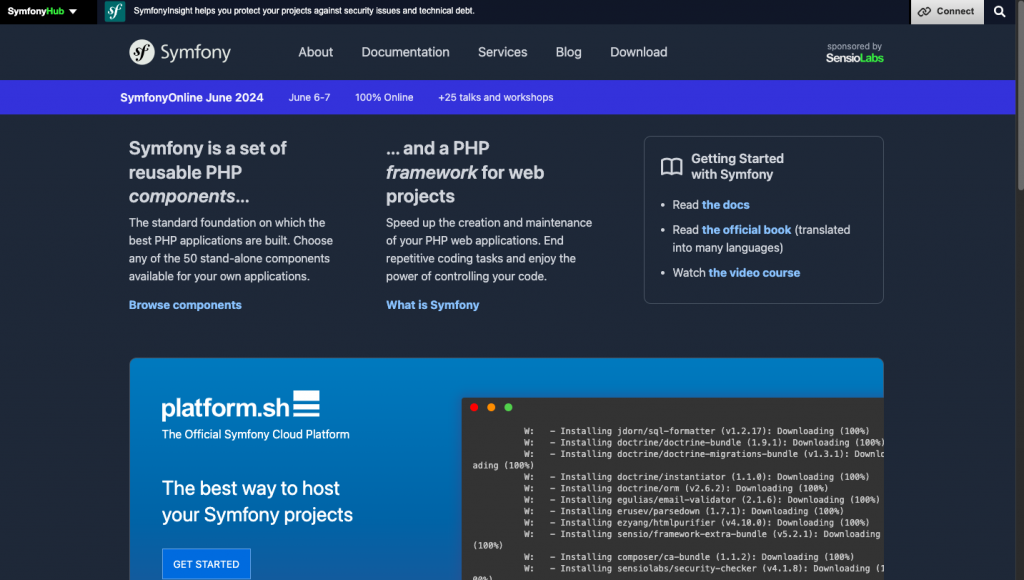
Symfony is one of the most popular open-source and established reliable PHP frameworks available for large-scale projects. It has remained a preferred choice among developers since its launch in 2005 by Fabien Potencier.
Latest Version: v7.0
It uses a system of reusable components. Specialists use this full-stack PHP framework to create web applications, APIs, and microservices. With many features and functionalities, it’s an ideal option for experienced PHP users.
Features
- Modular Component System: Symfony’s modular architecture allows developers to use only the required components they need, enhancing flexibility and scalability.
- Professional Support: Symfony offers professional support services, ensuring developers have access to assistance and guidance when needed.
- Doctrine ORM: It seamlessly integrates with Doctrine ORM, providing powerful tools for database management and object-relational mapping.
- Twig Templating Engine: Developers can easily create dynamic and reusable templates for applications using Twig, Symfony’s robust templating engine.
- LTS Releases: Symfony provides Long-Term Support (LTS) releases, guaranteeing updates and support for a defined period, ideal for enterprise-level stability.
- Comprehensive Testing: Symfony includes integrated unit testing automation, allowing developers to ensure their applications’ reliability and quality easily.
Companies using Symfony PHP Framework Components?
These are just a few examples of companies that leverage Symfony for their web development needs.
- Spotify: The most common music application today.
- Facebook Ads API: Used for certain component development.
- BlaBlaCar: long-distance carpooling platform.
- Drupal: The content management system.
- Dailymotion: The video-sharing platform.
- Trivago: The hotel search engine incorporates.
Laravel
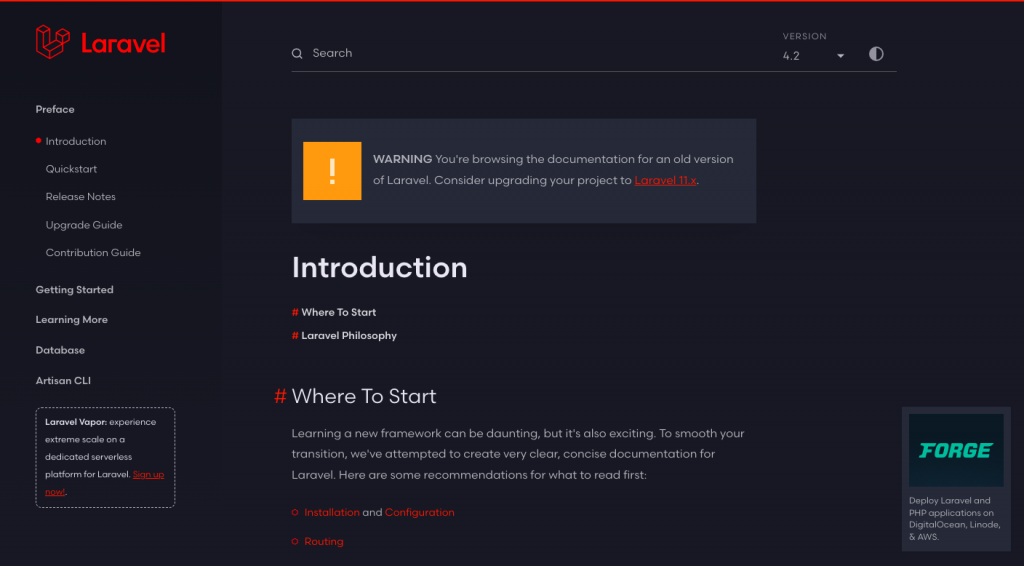
Based on Google Trends, Laravel was the most popular PHP framework last year and is still in demand as a user’s most preferred choice for web development projects. If frameworks were people, Laravel would be the king It’s an open-source software licensed under the MIT license. Since its creation by Taylor Otwell launched, in June 2011, it is an extensive and vibrant community of users and creators developed.
Latest Version: v11.x
The goal of Laravel is to simplify, refine, and elevate web development experience. The framework follows the MVC (Model-View-Controller) design and offers an extensive feature set. Its expressive, elegant syntax is simple enough even for a newbie to use making coding enjoyable and readable.
Features
- Eloquent ORM: Laravel’s elegant and expressive ORM (Object-Relational Mapping) allows developers to interact with the database using PHP syntax, making database management more intuitive and efficient.
- Blade Templating Engine: Laravel’s Blade templating engine offers a concise and intuitive syntax for creating dynamic web pages, making it effortless for developers to build intricate layouts.
- Artisan CLI: With the help of Laravel’s robust command-line interface, Artist, developers can easily handle various operations like database migrations, seeding, and boilerplate code generation.
- Middleware: Laravel’s middleware feature allows developers to filter HTTP requests entering the application, providing a flexible and customizable way to handle authentication, logging, and other cross-cutting concerns.
- Laravel Mix: Laravel Mix simplifies asset compilation and management by providing a fluent API for defining Webpack build steps, making front-end development more streamlined and efficient.
- Laravel Passport: It serves as an OAuth2 server implementation, offering a straightforward and secure method for user authentication and API token issuance. It is well-suited for constructing RESTful APIs and OAuth2 authentication systems.
Projects using Laravel PHP Framework Components?
These are just a few examples of companies that leverage CodeIgniter for their web development needs.
- BBC: The British Broadcasting Corporation.
- Crowdcube: The crowdfunding platform Crowdcube relies on Laravel for its backend infrastructure and API development.
- Expo: The Expo app development platform.
- Toyota: The automotive giant Toyota employs Laravel to build internal tools and management systems.
- 9GAG: The popular social media platform.
CodeIgniter

Let’s discover another Free, open-source framework, CodeIgniter which is an application development framework, used to develop websites, using PHP.
Latest version: 4.0.3
In simple terms, CodeIgniter is a lightweight, fast, and lightweight PHP framework that follows the Model-View-Controller (MVC) architecture, improving code organization, flexibility, reuse, testing, debugging, and maintenance. It offers a very rich set of functionality, made for fast startup and minimal asset overhead. This reduced footprint allows faster setup and better website development project runtime speeds.
Features
- Lightweight: CodeIgniter boasts a small footprint and uses fewer resources than other frameworks ensuring efficient resource utilization and rapid application development. This makes it perfect for applications requiring quick development and careful resource management.
- Extensive Documentation: Developers can quickly learn the framework’s concepts and functionalities with comprehensive documentation.
- MVC Architecture: CodeIgniter follows the Model-View-Controller (MVC) architectural pattern, promoting code organization and separation of concerns for enhanced maintainability.
- Built-in Security Tools: The framework includes built-in security features such as CSRF protection, XSS filtering, and data encryption, ensuring robust security for web applications.
- Active Community: It benefits from an active community of developers who contribute to plugins, libraries, and resources, fostering continuous improvement and support for the framework.
- Flexible Routing: The routing system offers immense flexibility, allowing you to define custom routes and URL structures that align seamlessly with your application’s needs. This empowers you to create user-friendly and SEO-optimized URLs.
Companies using CodeIgniter PHP Framework Components?
These are just a few companies leveraging CodeIgniter for their web development needs.
- SourceForge: Software development platform.
- Panasonic: Uses this for its Web Development Projects.
- Buffer: Social media management platform.
- HostGator: Web hosting services.
- Casper: Mattress e-commerce.
- Mailgun: Email automation.
Yii

Let’s discover another Free, open-source framework! The name Yii (pronounced Yee or [ji:]) means “simple and evolutionary” in Chinese.
and can also be interpreted as an acronym for “Yes It Is!” Yii is a PHP framework known for its component-based architecture and exceptional performance in developing modern web applications. While Yii is versatile and can be applied to various PHP projects, it excels in rapidly constructing large-scale web applications. Yii, a CMS, is a versatile web application framework that offers excellent support and customization, but beginners should proceed with caution due to its extensive learning curve.
Current version: 2.0.35
It prioritizes speed, security, and extensibility, offering features such as a robust caching system, an ActiveRecord implementation for database interactions, and the user-friendly code generator Gii. With its modular design, Yii enables developers to select and integrate only the necessary components, ensuring high levels of customization and flexibility.
Features
- MVC architecture: Yii follows the Model-View-Controller (MVC) architectural pattern, which separates the application logic into three interconnected components. This allows for better organization, code reusability, and easier web application maintenance
- Supports Caching: Yii provides built-in caching support to improve the performance of web applications by storing frequently accessed data in memory or other storage systems. This helps reduce database queries and enhances overall application responsiveness.
- High performance and security: Yii is known for its excellent performance and robust security features. It is optimized for speed and efficiency, making it suitable for developing high-traffic and resource-intensive web applications. Additionally, Yii incorporates various security mechanisms to protect against common web vulnerabilities and threats.
- Multiple database support: It supports various database management systems, including MySQL, PostgreSQL, SQLite, and Oracle. Developers can seamlessly work with different databases using Yii’s ActiveRecord ORM (Object-Relational Mapping) and query-building capabilities.
- Run third-party code: Yii allows developers to integrate third-party libraries, extensions, and plugins into their applications, extending the framework’s functionality and capabilities. This enables developers to leverage existing solutions and resources to enhance their Yii-based applications without reinventing the wheel.
- Gii: Gii is Yii’s powerful code generation tool that automates processing code creation for models, controllers, forms, and other components. It accelerates development by generating boilerplate code based on database tables and reducing manual coding efforts.
Companies using Yii PHP Framework Components?
These are just a few companies leveraging Yii for their web development needs.
- Huawei: The multinational technology company.
- Microsoft: Microsoft uses Yii for various projects and initiatives.
- LinkedIn: The professional networking platform.
- National Geographic: The Media Brand uses Yii components of its web development and content management systems.
- Canon: is a renowned imaging and optical products manufacturer.
- WeChat: social media and messaging platform in China.
CakePHP
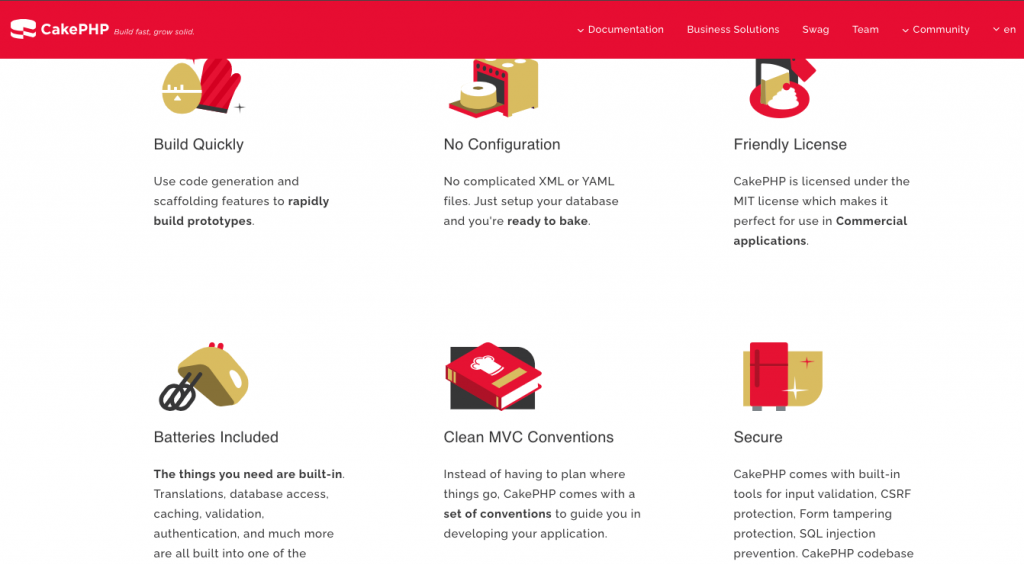
In 2005, an open-source PHP framework that follows the convention-over-configuration principle was launched for community web developers intending to revolutionize web development. This framework is perfect for beginners, designed to make designing web applications in PHP simpler, faster, and require less code.
Latest version: CakePHP 4. x
Tatarynowicz created CakePHP, intending to build a PHP web application without the hassle of coding. While coding may come easy for some, it can be harder for others to understand the complicated language.
Features
- Convention over configuration approach: It follows a convention over configuration approach that simplifies development. By relying on established conventions, CakePHP reduces the need for manual configuration, making it easier to maintain codebases.
- Flexible and extensible architecture: Developers can customize CakePHP’s functionality by integrating third-party libraries and creating new components, which enables scalable and modular application development due to its flexible design.
- Active and supportive community: CakePHP has an active and supportive community of developers, contributors, and users who provide assistance, share knowledge, and contribute to the framework’s continuous improvement. The community-driven nature of CakePHP ensures that developers have access to resources, documentation, and community forums for troubleshooting issues and exchanging ideas.
- Built-in ORM for database abstraction: Object-Relational Mapping system simplifies database interactions, eliminating the need for complex SQL queries, and includes built-in validation and authentication for efficiency.
- Built-in Security: Baking security features such as input validation, CSRF protection, and session management directly into the application saves time, and effort, and ensures secure development practices.
Companies using CakePHP Framework Components?
These are just a few companies that leverage CakePHP for their web development needs.
- Hyundai: Automotive Manufacturer.
- BMW: Luxury Cars.
- Honda: Automobile Company.
- FedEx: Global courier delivery services for its logistics management.
- Nestle: Food and Beverage.
- Pfizer: Pharmaceutical Company.
2024 PHP Framework Comparison: Finding the Right Fit
This table concisely compares Key Features among the PHP frameworks, helping users make informed decisions based on their project requirements. We’re comparing the Top 5 PHP frameworks of 2024-
(Laravel, CakePHP, Symfony, Yii, and, CodeIgniter )
| PHP Frameworks Key Features | Laravel | Symfony | CodeIgniter | Yii | CakePHP |
| Release Year | 2011 | 2005 | 2006 | 2008 | 2005 |
| ORM | Eloquent | Doctrine ORM | Built-in ORM (Active Record) | Yii ORM | CakePHP ORM |
| Built-in Features | Authentication, Caching, Task Scheduling | Form Validation, Security, Internationalization | Form Validation, Security, Error Handling | Database Access, Caching, Authentication | Authentication, Caching, Database Access |
| Code Generation | Artisan CLI | Symfony Maker | Yes | Gii | Bake Console(CLI) |
| Performance | Efficient performance optimizations | Good performance optimizations | Lightweight framework | High performance | Yii’s templating system |
| Template Engine | Blade | Twig | Yii’s templating system | PHP-based views | CakePHP’s view system |
| Security | CSRF Protection, Encryption, Hashing, Authentication Middleware | Authentication, Authorization, Encryption, CSRF Protection | Authentication, Authorization, Role-based Access Control, | XSS Filtering, CSRF Protection, Input Data Validation | Role-based Access Control, CSRF Protection |
Are PHP Frameworks hard to maintain?
PHP developers face challenges in technology advancements and security, but the demand for their skills presents significant opportunities for PHP developers.
- Security Updates: Ensuring timely application of security patches to protect against vulnerabilities.
- Compatibility: We should be sure that our system is compatible with the latest versions of PHP and other dependencies.
- Codebase Maintenance: Regularly updating and refactoring code to maintain performance and scalability.
- Documentation: Keeping documentation up to date to help developers understand and maintain the codebase.
- Third-party Dependencies: Managing dependencies and ensuring they are kept up to date.
- Performance Optimization: Optimal application performance requires identifying and addressing bottlenecks to ensure smooth and efficient functioning.
- Bug Fixing: Identifying and fixing bugs to ensure the smooth functioning of the application.
- Codebase Legacy: Managing legacy code and ensuring it remains compatible with newer frameworks and technologies.
- Testing and Quality Assurance: Conducting regular testing and quality assurance to identify and fix issues before they impact users.
- Scalability: Ensuring the application can scale to handle increased traffic and user loads as the business grows.
Maximizing Benefits: Tips and Best Practices for Web Development?
The web development industry continually introduces new frameworks, technologies, and best practices. To stay competitive, PHP developers maintain current knowledge and regularly enhance their skill set. You’ll find multiple strategies and tips to improve your web development experience.
You can optimize your web development campaign‘s effectiveness, performance, and quality by paying attention to the following tips.
- Select the Appropriate Devices: choose the right tools and technology. Look into and select frameworks, libraries, and development environments that meet the needs and objectives of your project.
- Stick to recommended practices: Respect design patterns, best practices for development, and code standards. guarantee maintainability and scalability, with appropriate documentation, version control, and code organization.
- Prioritize Performance: Make sure your online apps are as fast and efficient as possible. Reduce load times and enhance user experience by optimizing pictures and assets, minimizing HTTP requests, and using caching methods.
- Test Frequently: To identify faults and issues early in the development process, integrate automated testing into your workflow. To make sure your apps are stable and dependable, and do unit, integration, and end-to-end tests.
- Stay Updated: Stay informed on the most recent developments in web development trends, technologies, and best practices. To maintain your competitive edge and provide top-notch web solutions, you must constantly pick up new techniques, try out new instruments, and adjust to changing industry norms.
Final Thoughts
We are wrapping up our exploration of the top PHP frameworks for 2024. I hope this detailed article proves helpful to you in choosing the proper PHP framework for you. Keep in mind that all the PHP frameworks featured in this article are free and open-source. It includes a variety of well-liked frameworks together with crucial information to help you make the right choices for your next web project.
The open-source community keeps surprising us with new frameworks and technologies that have made website and application development easier and faster. Despite the challenges, PHP framework developers have a bright future ahead of them. Their demand continues to grow in 2024, and there is nothing that can hinder this growth or use, as businesses increasingly rely on PHP frameworks for web development.
What are PHP frameworks, and why are they essential for web development?
PHP frameworks provide developers with a structured foundation for building web applications, streamlining development tasks, and promoting code organization and reusability.
How do I choose the right PHP framework for my next web project?
Consider factors such as project requirements, scalability, community support, and documentation, and be familiar with the framework’s architecture and conventions.
Are PHP frameworks suitable for both small and large-scale projects?
Indeed, PHP frameworks can handle a range of difficult projects. They offer the solid features and performance needed for enterprise-level projects, along with the flexibility and scalability needed for small-scale applications.
What typical difficulties do web developers face while using PHP frameworks?
A learning curve for beginners, following framework norms, speed optimization, and keeping up with security patches and framework changes are a few possible roadblocks.
How can developers stay updated with the latest trends and advancements in PHP frameworks?
By actively participating in community forums, attending conferences and webinars, subscribing to relevant websites and social media channels, and regularly going through official documentation and tutorials offered by framework maintainers, developers may stay updated.
How do PHP frameworks handle security vulnerabilities, such as SQL injection and cross-site scripting (XSS)?
PHP frameworks come with built-in security features like input validation, output escaping, and CSRF protection to ensure safe interactions with databases. Framework maintainers also release regular updates to fix any security vulnerabilities.
